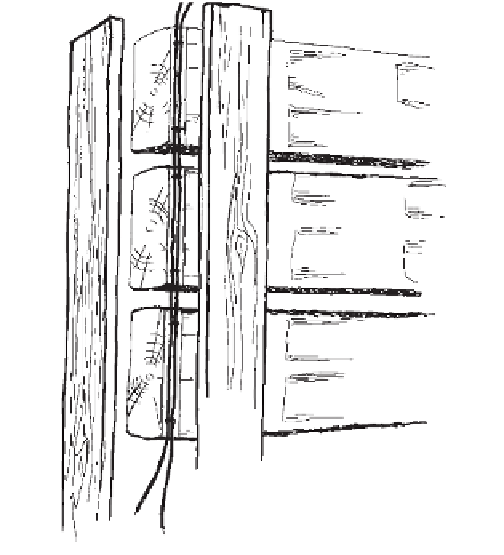Civil Engineering Reference
In-Depth Information
in the chinking. Most locations let you, the owner, wire
your own house, but require that an electrician have a
master's card.
We always drill vertical one-inch holes for the wire
at the doorways, down into the crawl space and up
past switch height, on up through the top plate for
access into the ceiling or roof. For overhead lights, we
often route out a groove in a beam before we floor
upstairs, and drill through for the fixture.
Power companies frown on the practice of embed-
ding wiring in concrete, on the theory that acids will
eat it, or at least the insulation off it. Maybe they're
right; I have no idea what chemicals badger each other
in those combinations. Metal conduit can be used
here, however.
It's obviously easier to properly wire a log house (or
any other house) before it's complete, so I advise you
to go ahead with it. Even the hardiest of my forest-
dwelling cohorts entertains schemes to produce his
own power someday, and even minimal electricity
flows better through adequate circuits.
Do get specific instructions before you wire. It's
expensive to have to do it over. There are numerous
how-to topics on the subject available from the library
or bookstore. And you can take courses in residential
wiring at the local vocational/technical school.
Of course, this could be the ideal place to spend
your dollars on a professional. He'll cost you $40-$60
an hour, however.
Electric wires can be boxed in under window and door trim (as shown
here) but are better installed in holes drilled through the logs during
assembly. Get specifications from the county inspections office.
Your panel will have a main disconnect switch,
which lets you shut off everything and avoid getting
burned. Every electrician I know has at least once
turned off the wrong breaker switch and discovered it
by burning off the end of his screwdriver on a “dead”
circuit.
Three-wire or two-wire-with-ground, 12-gauge
plastic-covered cable (Romex) is standard for house
wiring. Staple it with the wide, padded staples made
for that purpose. Run circuits wherever possible
between logs.
Vertical wiring goes up best through
drilled logs,
but can be done nicely in a space left by beveling the
log ends, to be covered by facings at windows and
doors. Metal plates must be put over these, so nails
cannot be accidentally driven into the wires later.
Sometimes we bore two intersecting holes through a
log to escape a cul-de-sac at a corner. And with a
raised wood floor, lots of the wire can be strung under-
neath to come up through maybe one log to the out-
lets. The outlets look best mortised into the log faces,
which means drilling from the chinking crack into the
recessed mortises. It's hard to get outlet boxes set flush
Wiring for Telephone
You may miss the telephone the least or the most,
depending on your hang-ups and whether you oper-
ate a business, as we do. Linda could not run her
publications operation or my construction business
without a phone, and wouldn't want to run her life
without one. And now faxes and modems are routine
in even the smallest offices.
Very simply, the telephone company has to be able
to reach you if you want the joys of conventional long-
distance conversations. The company will just about
always come in on an electric company pole, and will
let you bury its line in the same ditch as the electric
cable, at a reasonable 12-inch distance to avoid static.
Or it will bury the line for you at no cost.



